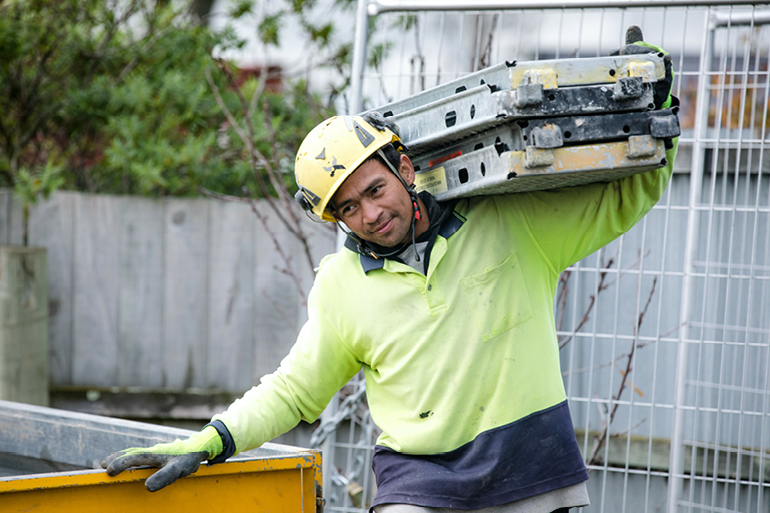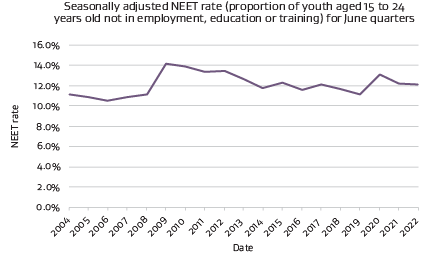Outcome 2: Skilled people engaged in safe and fulfilling work
Supporting a responsive labour market where people are protected and can make the best use of their skills.
On this page
It is important workers have a sense of security as the job market and economy continue to shift, due to events such as global pandemics and natural disasters, technology advancements, and the move to a low- emissions economy, with changes to the way we do things. The proposed Income Insurance Scheme will better protect workers and the economy in case of loss of employment by supporting workers with 80 per cent of their income for up to seven months, if they lost their job through no fault of their own. This would give people the time and financial security to find a good job that matches their skills, needs and aspirations, or take part in training or rehabilitation for a new, fulfilling career.
Providing opportunities for people to upgrade their skills lets them do better socially and economically – increasing their resilience and ensuring they remain part of their local communities. With this in mind, MBIE is supporting the 15 Regional Skills Leadership Groups across the country to develop regional workforce plans that support the future of work. The leadership groups provide a regional voice on workforce issues that is grounded in local knowledge, experience and insights.
They identify and support better ways to meet future skills and workforce needs in their regions, both now and in the future.
Even in the 21st Century, slavery remains a concern. During April and May 2022, MBIE sought feedback on new legislation aimed at addressing concerns about modern slavery and worker exploitation both here and internationally, focusing on freedom, fairness and dignity. The consultation generated over 5,000 submissions. The high level of feedback was partly due to the support of our Modern Slavery Leadership Advisory Group, with experts from across academia, business, unions and civil society, and our extensive engagement with a range of stakeholders, including use of social media and webinars. The legislation will create new responsibilities across the operations and supply chains of all types of organisations operating here. Medium and large organisations will be required to disclose the steps they are taking in response. Large organisations would have to assure themselves that their supply chains were free of such exploitation.
MBIE also led the development of the Fair Pay Agreements Bill, which was introduced to Parliament in March 2022. Described as the biggest change to labour market policy in 30 years, the Fair Pay Agreements aim to create a bargaining mechanism by setting binding minimum terms and conditions for an occupation or industry. In expectation of the Bill being enacted, MBIE is designing the necessary implementation and monitoring systems, and developing accessible information and educational material to support all relevant groups.

STORY: Construction Skills Action Plan
The construction sector is essential to our national wellbeing. As the country’s fourth- largest employer, it makes up approximately 10 per cent of the national workforce, and the homes and buildings it generates provide important spaces for whānau and communities.
The Construction Skills Action Plan was set up in 2018 to address skills and labour shortages in the construction industry. Managed by MBIE, the plan encompassed six initiatives led by MBIE, the Ministry of Social Development (MSD) and Tertiary Education Commission. The plan aimed to get the right people, with the right skills, to meet New Zealand’s current and future construction needs.
The Construction Skills Action Plan was completed in October 2021, having greatly exceeded its initial goal of helping around 4,000 people into construction-related education and employment. Collectively, it helped over 30,000 people, more than seven times the initial goal. This included around: 3,500 people who secured construction job placements through MSD’s Mana in Mahi programme; 3,500 people into training through MSD’s Expanding Skills for Industry programme; and 21,700 people who enrolled in construction- related education and training through the Tertiary Education Commission’s Growing Careers and Credentials programme. Each agency will now continue its own initiatives separately.
The Construction Skills Action Plan supported the sector to be in a stronger position for when the COVID-19 pandemic arrived, and while the sector continues to face challenges our efforts to grow the construction workforce continue.
Further work is being explored through the Construction Sector Accord’s Transformation Plan 2022-2025. One of the goals is to create a more skilled and diverse workforce that is future ready. The construction skills strategy and the Diversity Roadmap from the first plan will be the foundation to build an Action Plan and deliver a range of actions through government and industry partnership to grow the capacity and capability of the construction workforce.
How we measure outcome two
Performance measure

2.1 Reduce proportion of people not in employment, education or training (NEET)[3]
Indicator
NEET rate (15–24-year-olds)
Commentary
The seasonally adjusted NEET rate (proportion of youth aged 15 to 24 years old not in employment, education or training) decreased to 12.1% in the quarter to June 2022.
This is similar to the quarter to June 2021, when it was 12.2%. From an increase in NEET rates, that corresponds to the first year of COVID-19, the rate is now more consistent with longer term levels of around 12%.
| Performance measure | Indicator | Trend | Commentary |
|---|---|---|---|
| 2.2 Increase skilled workforce (part one) | Qualification attainment rate: Percentage of 25–34-year-olds with New Zealand Qualifications Framework (NZQF) level 4 qualifications or above | Current Desired |
The qualification attainment rate for young adults (measured by the percentage of 25-34-year-olds with NZQF level 4 qualifications or above) was 59.6% in the quarter to June 2022, 0.2 percentage points lower than in the quarter to June 2021. The qualification attainment rate has increased by 6.6 percentage points in the last 10 years. |
| 2.2 Increase skilled workforce (part two) | Skilled occupation rate | Current Desired |
The skilled occupation rate was 65.2% in the quarter to June 2022, 0.6 percentage points higher than in the quarter to June 2021. This rate has been increasing steadily since 2004. The rate is the proportion of people employed in an occupation assessed as “skilled or higher” by the Australian and New Zealand Standard Classification of Occupations (ANZSCO). |
| 2.3 Increase skill matching of migrants | Proportion of employed principal migrants whose occupations in New Zealand match their Aotearoa skills and NZ-ready qualifications | Current[4] Desired |
88.0% of employed skilled principal applicants agreed that their current role in their main job matches their skills and qualifications. This result is as small increase on the 2020 survey result of 87.1%.There has been some volatility in this result in the last 10 years, with fluctuation between 80% and 89% |
| 2.4 Increase employment | Total employment rate | Current[5] Desired |
The seasonally adjusted employment rate was 68.5% in the quarter to June 2022. This is a small increase from 67.8% in the quarter to June 2021. The seasonally adjusted employment rate for the June quarter has increased by 5.1 percentage points since June 2013 |
| 2.5 Reduce underutilisation | Total underutilisation rate | Current[6] Desired |
The seasonally adjusted underutilisation rate was 9.2% in the quarter to June 2022, decreasing from 10.5% in the quarter to June 2021. |
| 2.6 Reduce unemployment | Total unemployment rate | Current[7] Desired |
The seasonally adjusted unemployment rate was 3.3% in the quarter to June 2022. This is a decrease of 0.6 percentage points from June 2021. |
| 2.7 Increase pay equity | Difference in median hourly earnings for men and women | Current[8] Desired |
The gender pay gap (measured by the percentage difference between men’s and women’s median hourly earnings) was 9.2% in the year to June 2022. This is a small increase of 0.1 percentage points from June 2021. The gender pay gap has remained relatively flat over the last five years. |
| 2.8 Reduce fatal and serious work-related injury (part one) | Fatal injury rate (age standardised rate per 100,000 FTE workers) | Current[9] Desired |
The three-year average fatal injury rate (age standardised rate per 100,000 full-time equivalent (FTE) workers) was 2.2 for the period 2018-2020* (provisional figures), somewhat higher than 2.1 in the previous three-year period (2015-2017). |
| 2.8 Reduce fatal and serious work-related injury (part two) | Serious non-fatal injury rate (age standardised rate per 100,000 FTE workers) | Current[10] Desired |
The serious non-fatal injury rate (age standardised rate per 100,000 FTE workers) was 16.5 (provisional figure) in 2020*, decreasing from 18.3 in 2019 but increasing from a low of 14.2 in 2016. |
*At the time of writing, this was the most recent period for which data is available.
[3] Labour market indicators are only reported here at sub-population level where there is a statistically significant difference between the subgroups.
[4] A total of 5,015 respondents completed the Migrant Survey in 2021/22 and the overall survey response rate was 33%.
[5] Labour market indicators are only reported here at sub-population level where there is a statistically significant difference between the subgroups.
[6] Labour market indicators are only reported here at sub-population level where there is a statistically significant difference between the subgroups.
[7] Labour market indicators are only reported here at sub-population level where there is a statistically significant difference between the subgroups.
[8] Labour market indicators are only reported here at sub-population level where there is a statistically significant difference between the subgroups.
[9] The latest available data for this indicator is 'provisional'. Statistics New Zealand notes that 'Validated data on fatal injuries is only available up to 2018 to allow for the coroner's verification process for cause of death.'
[10] The latest available data for this indicator is 'provisional'. Statistics New Zealand notes that 'Data for 2020 is provisional.'

